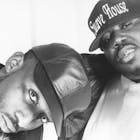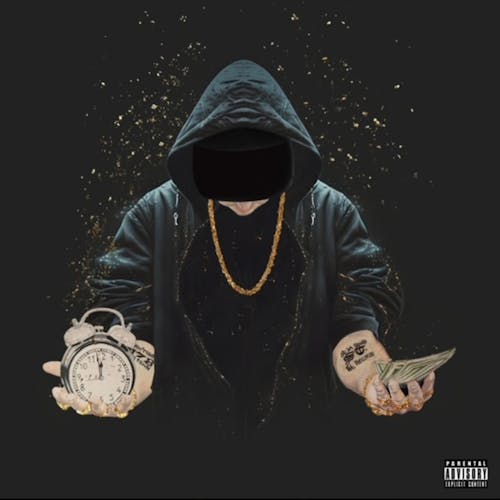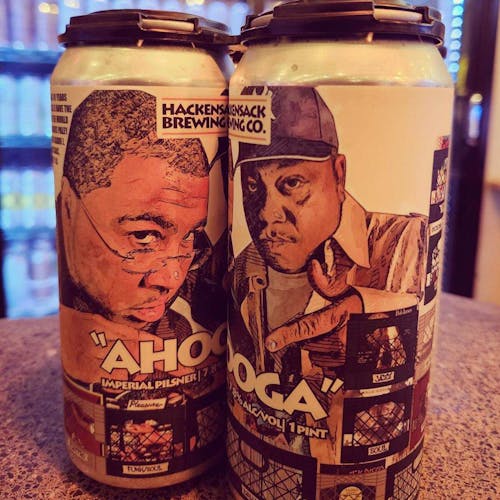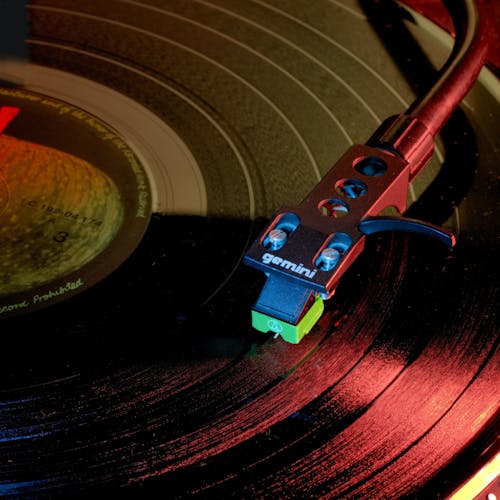
Scarface Has Rap's Best Discography
Don't Argue With Facts: Scarface Has Rap's Best Discography
Published Mon, May 17, 2021 at 1:15 PM EDT
It’s the day before the 2008 VH1 Hip Hop Honors and Brad Jordan, who is set to perform a tribute to legendary musician Isaac Hayes at the event, is hanging out in an Atlantic Records recording studio, playing the guitar backwards.
He’s a lefty, and there were no left-handed guitars on deck when he got the urge to play, so undeterred, he flipped the guitar around and played that way. He shrugs when asked about it, grinning before refocusing on the instrument.
It’s a calm moment for the artist known to the music world as Scarface. He finds solace in the guitar (his musician uncles taught him to play when he was a boy), and its welcome distraction as he gives his umpteenth interview about his pending album, 2008’s Emeritus. The album is a big deal. Just six years earlier, in 2002 he released what’s regarded as possibly his best work, The Fix. The album was made during his five-year tenure as president of Def Jam South (he held the post from 2000-2005), signing Atlanta-based rapper Ludacris, who’d go on to sell millions of records.
In 2008, he was basking in the unadulterated respect that he’d been due for years, as a rapper and musician, as evidenced by his VH1 Hip Honors appearance. He was finally being recognized as one of the best to ever do it, with the influence and discography to back it up.
Fast forward more than 10 years since he sat in the NYC studio, playing the guitar backward, and Face’s legacy has not only remained unshaken but grown stronger. His influence extends beyond the cliche label of being “your favorite rapper’s favorite rapper.” He isn’t just the blueprint for vulnerable rap penned by emcees who wrestle with internal demons, grapple with the afterlife, and pontificate on their place in a corrupt, racist world, a sound made popular by rappers like Tupac, Kid Cudi, Kanye West, Mac Miller, and Kendrick Lamar. His lyricism isn’t just the cornerstone for street rap laced with perspective, deep self-awareness and introspection, themes later explored by rappers like Jay-Z, Nas, T.I., and Rick Ross. And he’s more than the guitar-licked blues sound that defined 90s southern hip-hop and laid a musical foundation for what the region would birth next.
Scarface is all of those things.
He encompasses the best parts of hip hop by simply uncompromisingly being himself. His long discography began with his first outing with the Geto Boys in 1989 and winds its way through the years until his most recent release, 2015’s Deeply Rooted. When all is said, Scarface probably has the strongest discography in rap history, and one of the best in music. It features three agreed-upon classics: Mr. Scarface Is Back, The Diary, and The Fix, with genre and legacy-defining albums in-between, including The Untouchable and Emeritus. And that isn’t even touching his work with Geto Boys, whose discography includes one of the best group albums in rap, 1995’s The Resurrection.
A Houston native, Scarface grew up around musicians, and listened to classic rock and blues. He says his uncles would often gather in his living room in the city’s South Acres area, and have jam sessions, which he witnessed and later joined.
Scarface’s guitar-skills were later used on his own records, most of which he either produced or co-produced alongside frequent collaborators, Houston native Mike Dean and New Orleans’ N.O. Joe. It isn’t talked about a lot, but the live instrumentation in his music, is a marker for Face’s sound, adding a level of soul and depth.
In the 80s, after releasing music around Houston under his first moniker, DJ Akshen, Scarface signed to J. Prince’s Rap-A-Lot Records and joined Geto Boys when the group’s two original members were replaced. In 1989, the Geto Boys released Grip It! On That Other Level, an album that helped define Houston’s sound, and that of the South as a whole. It also served as a blueprint for street rap across the board, and has since been revered as a classic outing (the album was later remixed by Rick Rubin for the Geto Boys re-release album).
But Scarface’s fame shot to another level when he dropped his solo debut, Mr. Scarface Is Back, widely considered one of the best solo debuts in rap history.
It arrived just a few months after what would become Geto Boys’ most well-known album, We Can’t Be Stopped, which shot to infamy courtesy of the eerie rap classic “Mind Is Playing Tricks On Me,” which Face famously wrote in its entirety, with the exception of Willie D’s verse. That song offered a glimpse into Face’s intricate storytelling that sometimes skirts on the edges of insanity, something he’d further explore on his solo debut.
Mr. Scarface Is Back delved deeper into his psyche, with songs like “I’m Dead,” where he weaves a raw, eerie tale about his death, which was inspired by his labelmate, Gangsta N-I-P, and “A Minute to Pray And a Second to Die,” which interpolates Marvin Gaye’s “Inner City Blues.” As a teen, Scarface battled depression, and attempted to commit suicide, and as an adult was diagnosed with manic depression. His nuanced struggles with his mental health, and constant soul-searching in his music became one of the most relatable aspects of his music, evidenced on “Diary of a Madman,” where he contemplates, then rejects suicide as he stews in emotional isolation.
DROP YOUR EMAIL
TO STAY IN THE KNOW

I’m confused and I don’t know what to do / I’m hoping you can help me cause there’s no one else to talk to / I want to die, but it ain’t for me / I try to talk to my dad, but my old man ignores me…”
Decades later, rap witnessed rappers confronting their mental health in their music, much in the same way Face did from the onset of his career.
Scarface followed up his acclaimed debut with The World Is Yours, which out performed his debut, peaking at #10 on the Billboard 100 and achieving gold status. While his sophomore effort, produced almost entirely by N.O. Joe, isn’t a standout in his catalog, there were still shining moments, including the soul-searching “Now I Feel Ya.”
Between 1994 and 2002, Scarface had his pivotal almost decade-long run — a time that, when looked back upon, has come to define his career and the impact of his creative output. The era kicked off with 1994’s classic entry, The Diary, which remains not just a standout out in Face’s discography, but one of the greatest rap albums of all time.
The album, which hit #2 on the Billboard 200 and went platinum, was gritty-blues, with N.O. Joe, Mike Dean, and Scarface himself handling most of the production, and it signaled a shift from Face’s previous production, which was dark, grimy, and more sample-heavy. The Diary was street, but it was also smart and sharp-edged and impassioned, as Face tackled his inner turmoil, which was nurtured by his place in a country that never fully recognized him as human. This is most plainly illustrated by a standout on the project in in Scarface’s discography, “Hand of The Dead Body” featuring Ice Cube and Devin the Dude, where they lament American media’s affinity for blaming rap music for issues that existed long before Tupac and Spice 1 delivered their first bar.

They claim we threats to society / And now they calling on the government to try and make somebody quiet / For the bullshit they done to me / Gangsta Nip, Spice-1 or 2Pac never gave a gun to me…”
Scarface’s storytelling was arresting and vivid throughout the project, especially on songs like the opener “White Sheet,” “Jesse James,” “Goin Down,” and of course, what’s now maybe his signature, creepy solo track “Seen a Man Die.”
Scarface followed up The Diary with two group efforts in 1996 — the lesser-known gem, The Other Side of The Law with Facemob, which further introduced Devin the Dude following his Odd Squad release, and Geto Boys’ standout offering, The Resurrection. The Resurrection is arguably the Willie D, Face, and Bushwick Bill at their collective best, and the album explores spirituality (“Blind Leading The Blind"), the lingering effects of centuries of racism (“The World Is A Ghetto), and the wisdom and street-smarts that subjugation produced (“Time Taker”). It’s weary and enraged, and sonically leans heavily into blues, organ-based production, most of which was handled by Mike Dean and Scarface.
A year later, Scarface would keep the momentum going with the release of his fourth solo album, The Untouchable, which debuted at #1 on the Billboard 200, and went platinum. Anticipation for the album was heightened by 2Pac’s feature on “Smile,” since he was tragically killed just a few months before the album dropped. The song remains one of Pac’s best posthumous appearances, and a standout in both of their catalogs, matching the pair’s ability to weave spirituality into thoughtful musings about race and poverty. If The Diary was gritty, with Face troubled and aggravated with the way of the world, The Untouchable is Face turning his hard-earned wisdom toward the people around him and encouraging them to listen (“Money Makes The World Go Round,” featuring Daz Dillinger, Devin the Dude), and KB, (“Smartz” featuring Devin). He’s calmer this go around, though no less intense, and the album also offers two Face classics, “Southside” and what’s come to be one of the best songs in his long catalog, and one of the greatest rap productions of the past 30 years, “Mary.” This is the album where Face definitively morphed into “your favorite rapper’s favorite rapper,” graduating with the times, without compromising his style or sound.
In 2002, Scarface dropped The Fix, following the release of 2000’s fan-favorite Last of Dying Breed featuring one of Face’s hardest ruminations on his life and career, “Look Me In My Eyes.” The album came a couple of years into his time as President of Def Jam South, and Face was spending a lot of time in New York, which influenced his outlook and his ear.
While there’s still debate over whether The Fix is Scarface’s best album or if it’s The Diary, it’s certain that there were few rappers who’d attained his his level of respect when the album dropped, even if it wasn’t his biggest seller (it peaked at #4 on the Billboard 200). The Fix was a culmination of all the things that Face did best— emotional storytelling (“On My Block”) vivid displays of dirt-wrapped wisdom (“In Between Us,” “Heaven”), spiritual pondering (“Someday,” and “What Can I Do”) and gritty street warnings (“Keep Me Down”).
The album veered in a different direction production-wise, featuring standouts from a young Kanye West (“Guess Who’s Back” featuring Jay-Z and Beanie Sigel), The Neptunes (“Someday”), and Nottz (“Keep Me Down”). But it was Suave House alum, T-Mix, who handled the bulk of the production, delivering his signature deep-soul asphalt sound to anchor an especially focused Scarface’s lyricism.

America the Beautiful, don't be so cold/How do you expectin' our seeds gonna grow?/When you trap us in the ghetto/And show love, to the other muthafuckers/While we right here starvin' at home..."
Face’s strong point has always been knowing precisely who he is as a rapper and never swaying from that as a starting point.
In 2006 he dropped the sleeper gem, One Hunnid via The Product, a collaboration with west coast rapper Wilie Hen (San Quinn’s brother) and Mississippi rapper, Young Malice. The album was chock-full of grimy escapades (“Hustle,” “Pride,” “G Type”) shaped by deep bass lines and swinging, relatable melodies on the hooks. Face was playing music mentor again - must as he did with Facemob - and having fun showcasing how capable he was lyrically, no matter what he was talking about.
Months before the historic election of Barack Obama, and with police killings and the disenfranchisement of Black people heavy on his mind, Scarface released Emeritus in 2008. Filled with socio-political musings and featuring an especially memorable appearance on “Can’t Get Right” from Bilal, who was battling with his own disillusionment with the industry, the album was Face’s best since The Fix. It featured a handful of Houston peers, both famous and underrated, including Bun B, K-Rino, and Z-Ro, and stands as one of his best, if not widely acknowledged outings. Seven years later, Face released what he says might be his last album, Deeply Rooted. Featuring production from N.O. Joe and appearances from regular collaborators, Nas, Z-Ro and Rick Ross, as well as drop-ins from John Legend and Cee-Lo, the album was an indication that whenever Scarface feels like rapping, he’s always welcome.
The debate about the best rapper in Hip Hop history and the best albums will be around for as long as the music exists, but no matter where you place him, Scarface’s name will always pop up in those conversations, bringing levity, nuance, and acknowledgement to the creativity Hip Hop is capable of producing.






